B737-200 TinMouse – Auto Flight Tutorial(English)
Posted by Duff | Posted in Aeronaves , Tutorial
Trago-vos esse belíssimo tutorial sobre o TinMouse B732
Video-Tutorial:
*************

B737-200 Advanced projects
AUTO FLIGHT
Our 737-200 provides three systems for guidance and automatic flight: Flight Director, Autopilot, and the Approach Progress Display.
Flight Director
A flight director gives pilots visual cues to follow by hand-flying the airplane to reach a desired roll and pitch attitude. The flight director components are the flight director indicator (FDI) and a control panel.
It is very important to keep in mind that this model of Flight Director functions completely separate from the autopilot. The flight director can be set in one mode and the autopilot in a different mode. This is a common source of confusion with flight simulator pilots when introduced to this system.
Flight Director Indicator
Figure 1 shows our FDI, a combination of a typical attitude indicator, a fixed aircraft symbol (orange triangle), pitch and bank command bars (yellow inverted ‘V’), glide slope indicator (white triangle), a rising runway symbol, and a slip indicator.
To fly the aircraft with the command bars armed, the pilot changes the flight director to the desired mode, then hand flies the airplane until the top of the orange airplane symbol touches the bottom of the pitch and bank command bars. The command bars move up for a climb or down for descent, and roll left or right to provide lateral guidance. They cue for standard-rate turns to enable the pilot to reach and fly a selected heading or track. The bars also show pitch commands allowing the pilot to capture and fly an ILS glide slope, a preselected pitch attitude, or maintain a selected barometric altitude. When not using the bars, the pilot can move them out of view by switching the flight director off.
The glide slope indicator and localizer deviation indicator work as in any other instrument landing system.
The Rising Runway comes into view when a localizer frequency is set on the radio. It will then indicate deviation from the localizer. When descending through 200 feet AGL, the R ising Runway will start to rise and will meet the orange airplane symbol when touching down. The Rising Runway scale is divided into 50 foot increments.
Control Panel
The flight director control panel provides the input information required for the FDI. Figure 2 shows the flight director control panel. It consists of three components: Mode Selector Switch (MODE SEL), Altitude Hold (ALT HOLD) Switch, and the Pitch Command (PITCH CMD) Control.
Rotating the MODE SEL switch selects flight director computer reference signals provided to the command bars.
The MODE SEL has the following modes:
1. GA (Go Around): Used for when executing a Go Around. The command bars provide commands for wings level and a pitch attitude of 14 degrees until the Mode Selector is changed to another position. GA mode can also be selected by clicking the “GA” icon, but you must be in either Auto Approach or Manual Glide slope mode.
2. OFF: Removes or tucks away the command bars in the FDI.
3. HDG: The command bars provide commands to fly to and maintain selected heading on the HSI’s heading bug.
4. VOR/LOC: The command bars provide commands to maintain a VOR radial or localizer course selected on the HSI.
5. AUTO APP: The command bars provide commands to maintain a localizer and glideslope. Until the localizer is captured, you will remain in HDG mode. Glide slope will be automatically captured when the glide slope beam is intercepted.
6. MAN G/S: Manual Glideslope forces capture of the localizer and glideslope even if you are not on the beam. Use this mode if above the GS and capture not likely, but not more than ½ dot above.
7. BB: Back course mode. Will cue for tracking an ILS back beam.
The Altitude Hold (ALT HOLD) switch sets the command bars to provide commands to achieve the existing altitude shown in the altitude indicator at the time the switch is used. You must have a roll mode engaged before using. When on, the ALT HOLD switch is electrically locked. It will automatically shut off when the Mode Selector is turned to OFF or on glideslope capture.
The PITCH CMD Control selects fixed pitch angle for climb or descent. It will be inoperable (INOP) if ALT HOLD is ON, if glide slope is captured, or during Go Around. Left clicking will adjust pitch in tenths of a degree, while right clicking adjusts in whole degrees.
Autopilot
The Sperry SP-77 autopilot allows control of roll and pitch via two separate channels; they can be controlled simultaneously or separately using the paddles labeled AIL and ELEV. It is important to note the autopilot acts completely independent from the flight director. The autopilot can be used in the following modes:
- Manual
- VOR/LOC
- Auto Approach
- Manual Glide Slope
In conjunction with these modes, the following submodes are available:
- Control Wheel Steering
- Heading Off
- Heading Hold
- Turbulence
- Altitude Hold
Panel
1. Autopilot System Select Switch
The 737-200 has three hydraulic systems: A, B, and Standby. This switch selects the hydraulic system the autopilot and yaw damper uses. The ELEV channel only works when system B is selected. The AIL channel works with either mode.
2. Autopilot Mode Selector
MAN (Manual Mode) – This mode activates Control Wheel Steering (CWS) which is used to maneuver the airplane with either or both channels engaged. CWS basically functions as an auto trim.
When in MAN mode:
- ALT HOLD or TURB is selectable
- HDG SEL or HDG OFF is selectable.
VOR LOC (VOR/LOC Mode) – Used to automatically intercept the selected radio course; either a VOR radial, or the localizer part of an instrument landing system:
- HDG SEL or CWS is used to achieve the intercept heading, but CWS provides the pilot with more flexibility to compensate for simulator’s non-optimal VOR radial intercept routines
- Use the heading and course bugs in the Heading Selector Indicator to select heading and course
- You can use roll commands can to manually capture the VOR radial or ILS localizer, if you’re not using HDG SEL
- Crosswind compensation occurs after being ON COURSE
- ALT HOLD or TURB is selectable (TURB in VOR only).
AUTO APP (Auto Approach Mode) – Used to automatically capture both ILS Localizer and glide slope:
- Use HDG SEL or CWS to achieve the intercept heading
- LOC CAPTURE is the same as VOR/LOC mode
- LOC and G/S are armed when:
* ILS frequency is tuned;
* AUTO APP is selected. - G/S is captured at 1/3 dot
- ALT HOLD trips OFF at G/S capture
- Autopilot reverts to MAN if TURB is selected
- AUTO APP is not selectable unless ILS frequency is selected.
MAN G/S (Manual Glide Slope Mode) – Used to capture G/S from above or to re-capture after autopilot disengagement.
- When selected, the airplane pitches down for 10 seconds (700 ft/min) then tracks G/S
- GLIDE SLOPE light illuminates green immediately after selecting MAN G/S
- Operates the same as AUTO APP after G/S capture
3. Heading Switch
HDG OFF – Autopilot maintains any bank attitude within limits.
- Selectable in MANUAL mode only.
HDG SEL – Establishes preselected heading mode.
- Maintains the heading selected in the Heading Selector Indicator.
HEADING HOLD (center position)
- Bank angle <>
- Bank angle > 5 degrees – When the force is released, the airplane maintains bank attitude.
4. Autopilot Aileron (ROLL) Engage Switch
The aileron (roll) channel may be operated independently of the pitch channel in the MAN or VOR LOC modes of operation.
- The Mode Selector must be in MAN
- Will not engage if force is being applied to the control wheel.
5. Autopilot Pitch Mode Selector
TURB (Turbulence) – Decreases pitch attitude and rate gains.
- Bank angle is limited to 8 degrees in VOR LOC mode
- CWS, HDG SEL, HDG HOLD, and VOR modes are available
- Deselected by manually positioning switch to OFF.
OFF – Pitch Attitude hold or glide slope engaged.
- Spring-loaded to OFF at glide slope engagement
- Spring-loaded to OFF if force greater than high detent level is exerted.
ALT HOLD (Altitude Hold) – Pitch reference is to pressure altitude.
6. Autopilot Elevator (PITCH) Engage Switch
The elevator (pitch) channel may be operated independently of the roll channel in the MAN mode only. CWS will auto trim the airplane to keep the selected pitch.
Indicators
The autopilot uses the Disengage Light and Stabilizer Out of Trim Light indicator to alert the pilot of unusual circumstances.
1. Autopilot Disengaged Light (red)
This is the autopilot disengaged warning light, and it will come on each time the autopilot is disconnected. Just push the light, re-engage the autopilot, or press the Z key or programmed joystick button a second time to cancel the warning.
2. Stabilizer Out Of Trim Light (amber)
Functions only with the Autopilot Elevator Engage Switch ENGAGED.
ILLUMINATED – The stabilizer is out-of-trim for the condition required by the autopilot. It’s normal for it to come on when a pitch mode is first engage or during heavy autopilot trimming.
Approach Progress Display (APD)
On the main panel just above the altimeter is the APD, or Approach Progress Display. These lights display the status of your approach. The APD is divided into two columns – the left for the flight director and the right for the autopilot. Amber means that a mode is armed, and green means it is captured. In the above examples, figure 6 shows the flight director has the VOR/LOC armed, and the autopilot has the VOR/LOC and GS armed. Figure 7 shows that both the flight director and autopilot have captured VOR/LOC, but GS is still armed. Figure 8 shows both flight director and autopilot have VOR/LOC and GS armed. It’s important that these two columns of lights match each other, although it is normal for the flight director and autopilot to capture at slightly different times.
The APD lights can be tested by pushing on either column. The left side tests the amber lights, and the right side tests the green.
BY:Duff
usei e recomendo
PDF Download (english version): | FSBrasil |
Creditos: fsbrasil.wordpress.com


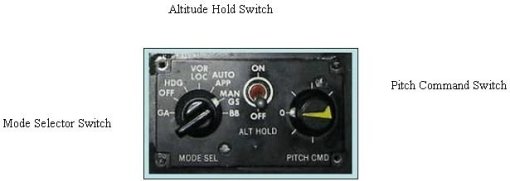
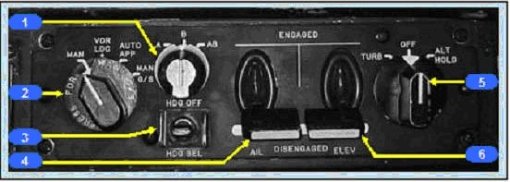
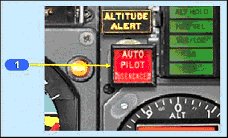

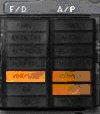
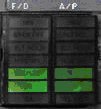
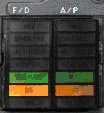
Comments (0)
Postar um comentário
.:Obrigado pelo seu comentário:.